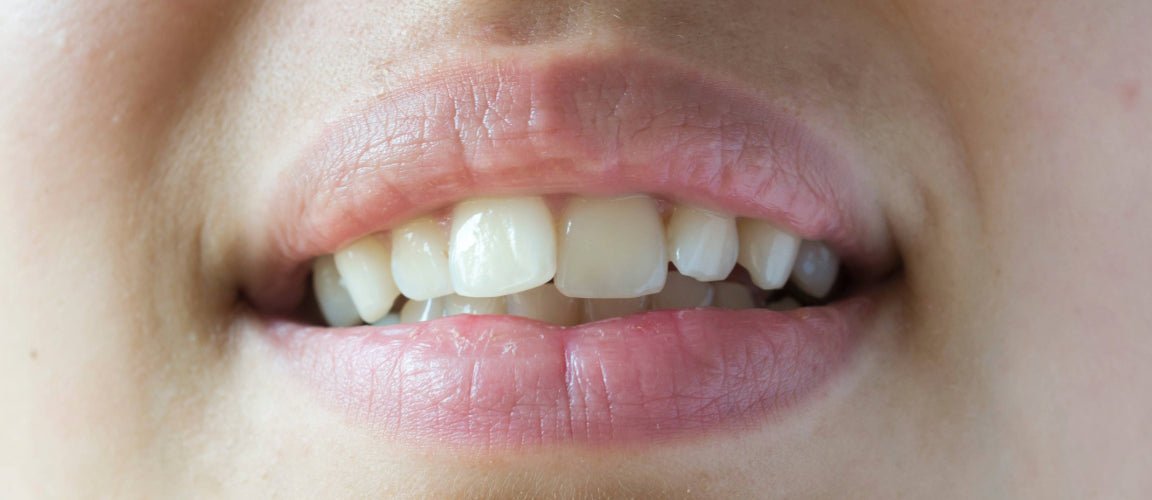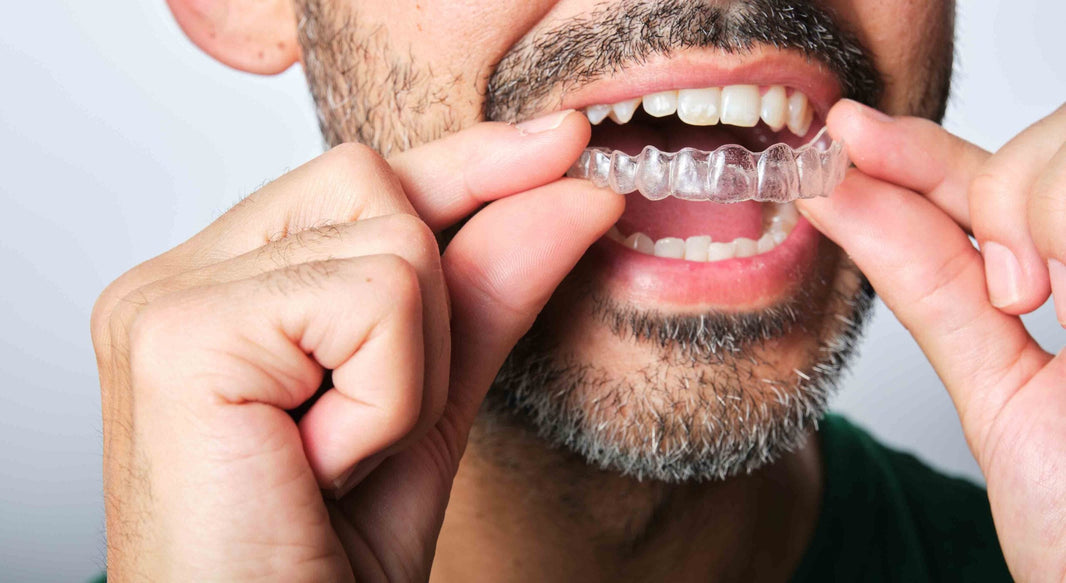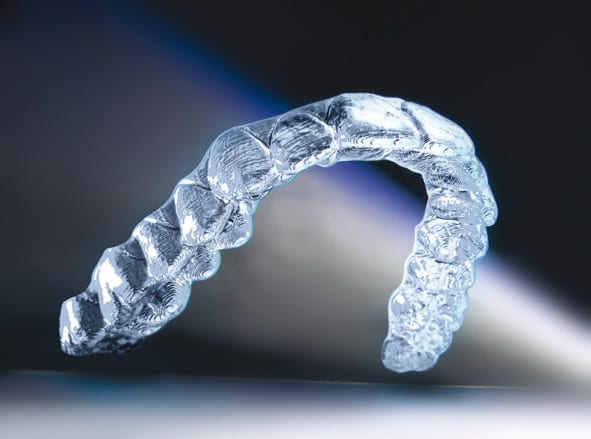A crossbite may sound like a minor dental issue, but it can significantly affect your oral health and overall well-being. If you've ever noticed misaligned teeth or experienced difficulty when biting down, you might be dealing with this common condition.
Understanding crossbite is important not only for achieving a beautiful smile but also for preventing potential complications down the road. In this comprehensive guide, we'll explore the key symptoms that could indicate a crossbite, the diagnostic process to identify it, and, most importantly, the effective treatment options available.
Table of contents
What is a Crossbite?
A crossbite is a dental misalignment where the upper teeth fall inside the lower teeth when the jaws are closed. Unlike an overbite, which involves vertical overlap, or an underbite, which projects the lower jaw forward, a crossbite involves lateral deviation — essentially, the teeth don’t line up properly from side to side. It can affect a single tooth or multiple teeth and may be present in the front of the mouth (anterior crossbite) or the back (posterior crossbite).
From a clinical perspective, a crossbite reflects a mismatch between the width of the upper and lower jaws. In healthy occlusion, the upper teeth should slightly overlap the lower teeth all the way around the arch.
The American Association of Orthodontists estimates that 20-30% of orthodontic patients present with some form of crossbite.
Crossbites are not just cosmetic concerns — they’re classified as functional malocclusions. This means they can actively impair chewing, speaking, and even breathing patterns over time. That’s why orthodontic intervention is often recommended even in seemingly minor cases.
Types of Crossbites
Anterior Crossbite
An anterior crossbite occurs when one or more of the upper front teeth sit behind the lower front teeth when biting down. This is often mistaken for an underbite but differs because only select teeth are involved, not the entire jaw.
Anterior crossbites can be purely dental (caused by misaligned teeth) or skeletal (caused by an underdeveloped maxilla or an overgrown mandible). If left untreated, they can cause excessive wear on the front teeth , affect speech articulation, and contribute to jaw compensation patterns.

Posterior Crossbite
Posterior crossbites involve the back teeth , where the upper molars and premolars bite inside the lower ones. This often results in a patient shifting their jaw to one side when closing their mouth to achieve a more comfortable bite.
This compensatory movement can, over time, lead to facial asymmetry and long-term TMJ dysfunction. Posterior crossbites are particularly common in children and may stem from narrow palatal arches , thumb sucking, or prolonged pacifier use.

Single-tooth Crossbite
A single-tooth crossbite is a localized misalignment where one tooth — often a front incisor — erupts or shifts into an abnormal position, typically behind the opposing tooth rather than slightly in front as in a normal bite.
Though it involves only one tooth, the impact can extend beyond aesthetics: uneven enamel wear, gum irritation, and even jaw discomfort may develop over time.

Bilateral Crossbite
A bilateral crossbite occurs when the upper teeth on both sides of the mouth bite inside the lower teeth, typically due to a narrow upper jaw , a wide lower jaw , or a combination of both skeletal discrepancies.
This condition can involve the front (anterior) teeth, the back (posterior) teeth, or span the entire dental arch. Because both sides of the mouth are affected, bilateral crossbites are more likely to produce symmetrical but functionally compromised jaw growth , making early diagnosis and intervention critical for long-term stability.

Unilateral Crossbite
A unilateral crossbite is a type of malocclusion where the teeth on only one side of the mouth are misaligned, causing the upper teeth to bite inside the lower teeth (or the reverse) when the jaw closes.
Unlike bilateral crossbites, which affect both sides symmetrically, unilateral cases often trigger a functional shift in the jaw — meaning the lower jaw may deviate to one side during closure to compensate. This can lead to asymmetrical jaw growth, facial imbalance, TMJ strain, and uneven wear on the affected side.

What Causes a Crossbite?
Genetic Predisposition
Like many dental and skeletal issues, crossbites often run in families. If one or both parents have had a history of malocclusion, particularly narrow upper arches or prominent lower jaws, there’s a heightened risk their children may develop a crossbite. In these cases, the underlying bone structure (rather than the alignment of individual teeth) is to blame.
A 2019 study in the American Journal of Orthodontics and Dentofacial Orthopedics found that skeletal discrepancies — such as a transverse maxillary deficiency — had a significant heritability factor, particularly in cases of bilateral posterior crossbite.
Jaw Misalignment
A crossbite may reflect a mismatch in the widths of the upper and lower dental arches. In a balanced bite, the upper arch is wider and overlaps the lower arch. However, if the upper jaw fails to grow proportionally, or if the lower jaw grows too much, functional crossbite can result. This is often seen during puberty, when growth spurts can make pre-existing skeletal discrepancies more pronounced.
Cleft Palate and Craniofacial Abnormalities
Children born with cleft palate or syndromic conditions like Crouzon syndrome or Pierre Robin sequence often develop severe skeletal crossbites due to disrupted jaw development. These cases usually require multidisciplinary treatment involving surgeons, orthodontists, and speech therapists.
Prolonged Childhood Habits
Oral habits during developmental years can reshape jaw growth and encourage improper tooth eruption:
Thumb sucking beyond age 4 can push the upper teeth inward and distort the palate.
Prolonged pacifier use has been linked to posterior crossbite development, particularly when used past the age of 2.
Tongue thrusting and atypical swallowing patterns can cause improper pressure against the teeth, influencing their positioning.
Mouth breathing , often due to enlarged adenoids or allergies, can hinder normal maxillary development by disrupting the resting posture of the tongue — which ideally should rest against the roof of the mouth and aid in palatal widening.
Delayed or Premature Tooth Eruption
Timing matters. If baby teeth fall out too early , adjacent teeth may drift into the space, causing misalignment for incoming adult teeth. Conversely, if baby teeth overstay their welcome , they can block the proper eruption path of adult teeth, leading to a crossbite.
According to the Journal of Clinical Pediatric Dentistry, children with prolonged retention of primary teeth were 40% more likely to develop dental crossbites than those with timely exfoliation.
How to Identify a Crossbite
Identifying a crossbite early can prevent years of dental complications and invasive treatment down the line. According to the Journal of the World Federation of Orthodontists, early diagnosis of posterior crossbite in children can reduce the need for future orthognathic surgery by up to 70% if corrected before adolescence.
While some cases are visibly obvious—especially when a front tooth sits behind its counterpart—others may be more subtle, requiring trained clinical evaluation. Here’s how patients and professionals alike can recognize the signs.
Visual Indicators
Parents may notice these signs in children when observing speech, chewing, or even while smiling. In everyday observation, the following signs may signal a crossbite:
The midline of the upper teeth doesn’t align with the lower midline.
One or more upper teeth appear to lean inward , especially on biting down.
The jaw shifts to one side when closing, a behavior known as mandibular functional shift.
There is noticeable facial asymmetry , often with a flatter cheek or jawline on one side.
Self-Check Techniques
Jaw discomfort when chewing or a tendency to chew on only one side may also suggest malocclusion. While not diagnostic, patients can perform a basic self-check at home:
Bite down gently with your back teeth touching.
Look in a mirror and examine if your upper teeth sit completely outside the lower teeth.
If any upper tooth is trapped inside the lower arch , especially on the sides or in the front, you may have a crossbite.
Clinical Examination by a Dentist or Orthodontist
Professionals use a comprehensive approach:
Intraoral Examination : Direct observation of how the teeth come together, sometimes enhanced with bite registration materials.
Occlusal Analysis : Identifying midline discrepancies, cross-arch width issues, and functional shifts.
Palpation of the TMJ : To check for joint tenderness or clicking, which can indicate compensatory jaw movement due to misalignment.
Advanced Imaging and Tools
Orthodontists often rely on:
Panoramic X-rays : To view tooth roots, impactions, and spacing.
Cephalometric X-rays : For assessing jaw relationships and skeletal structure.
Cone Beam CT (CBCT) : Provides a 3D scan of the craniofacial structure—especially valuable in surgical crossbite cases.
Digital Scans and Models : Intraoral scanners offer a precise 3D map of the dental arches, which can be used for simulation, aligner planning, or appliance fitting.
Why Crossbites Are Harmful
Jaw Joint Dysfunction (TMJ Disorder)
Crossbites create uneven pressure on the temporomandibular joint (TMJ), often resulting in compensatory jaw movements . Over time, this imbalance strains the joint, leading to symptoms such as:
Clicking or popping sounds
Headaches or migraines
Earaches or a sense of fullness in the ears
Jaw pain or limited mobility
According to a study in The Journal of Oral Rehabilitation, patients with posterior crossbites are twice as likely to develop TMJ-related symptoms compared to those with normal occlusion.
Uneven Tooth Wear and Enamel Erosion
Because the bite force isn’t distributed evenly, some teeth endure excessive pressure while others are underused. This results in:
Premature enamel loss
Flat or chipped cusps
Tooth fractures
Increased risk of dentin hypersensitivity due to exposed inner tooth surfaces
Dental wear patterns are often the first sign a dentist observes when identifying a long-standing crossbite.
Gum Recession and Periodontal Stress
When teeth are not in proper alignment, the surrounding bone and gum tissues may not be able to support them optimally. This is especially true for teeth that are torqued or rotated to compensate for crossbite positioning. The consequences include:
Gum recession
Localized bone loss
Periodontal pocket formation
This not only jeopardizes the longevity of the teeth but may also compromise candidacy for restorative treatments like implants or crowns in the future.
Facial Asymmetry and Skeletal Deviation
Children with untreated crossbites often develop asymmetrical jaw growth . One side of the jaw may grow faster or shift laterally to compensate for the misaligned bite, resulting in:
Crooked smiles
Lopsided chins
Uneven facial musculature
Once facial bones mature (typically in the late teens), correcting this asymmetry may require orthognathic surgery, making early detection essential.
Crossbite Treatment Options
Treatment for a crossbite isn’t one-size-fits-all. It depends on the type (anterior vs. posterior), cause (dental vs. skeletal), severity, and the patient’s age. Early intervention often leads to simpler, more stable results, especially in children whose bones are still developing. For adults, treatment may involve more complex biomechanical or surgical strategies — but excellent outcomes are still achievable with the right plan.
Braces
Traditional braces remain the gold standard for correcting most dental crossbites, particularly in adolescents and adults. They apply controlled, gradual force to realign teeth into the correct position.
How it works : Brackets are bonded to the teeth and connected with archwires, which are periodically adjusted to move teeth into better alignment.
Use cases : Effective for both anterior and posterior crossbites caused by tooth misalignment.
Advantages : High control over complex tooth movements. Can incorporate elastics or auxiliary appliances for jaw manipulation.
Recent advancements like self-ligating braces and 3D digital treatment planning have improved comfort and predictability.
Invisalign
Clear aligners are now FDA-cleared for many forms of crossbite correction — particularly mild to moderate dental crossbites .
How it works : Patients wear a series of custom-designed trays that gradually shift the teeth.
Use cases : Ideal for adults and teens looking for a discreet option, particularly for anterior crossbite or single-tooth involvement.
Enhancements : Attachments (tooth-colored grips) and elastics are often added for better torque and control in crossbite cases.
Palatal Expanders
Used primarily in children and pre-teens, palatal expanders correct skeletal crossbites by widening the upper jaw before the growth plates fuse.
How it works : A custom appliance is cemented to the upper molars and turned with a key to gradually widen the palate over several weeks.
Best for : Bilateral posterior crossbite in growing patients.
Timing is crucial : After age 14–16, the mid-palatal suture fuses, and expansion becomes more difficult without surgery.
Expanders can also improve nasal airflow and airway volume , making them beneficial for children with sleep-disordered breathing.
Reverse-Pull Headgear (Facemask Therapy)
Used for skeletal anterior crossbites , especially when caused by an underdeveloped upper jaw (Class III malocclusion).
How it works : The device uses elastics or metal arms to apply forward-pulling force on the maxilla.
When it's used : Typically prescribed for children between ages 6–10.
Benefit : Can significantly reduce the need for jaw surgery later in life if used during peak growth periods.
Surgically Assisted Rapid Palatal Expansion (SARPE)
For adults with skeletal crossbite , where palatal sutures have fused, non-surgical expansion isn’t possible. SARPE combines orthodontics and oral surgery to facilitate bone remodeling.
Procedure : A minor surgery is performed to weaken the palate, followed by expansion using a mechanical device.
Best for : Adults with narrow upper jaws, especially when standard braces can’t create enough arch width.
Downtime : Mild swelling for a few days, with expansion continuing over 2–3 weeks.
Orthognathic Jaw Surgery
When crossbite is caused by significant skeletal discrepancies — such as an overly wide lower jaw or severely narrow upper jaw — orthognathic surgery may be the only effective option.
Procedure : The jaw is surgically repositioned, often followed by braces or aligners to finalize tooth alignment.
Candidates : Adults with functional limitations, facial asymmetry, or when conservative orthodontics has failed.
Recovery : 6–8 weeks for most healing, but full treatment may span 12–24 months.
Temporary Anchorage Devices (TADs)
In certain cases, orthodontists use mini implants as anchorage points to guide teeth into better alignment without needing headgear or elastics.
Use case : Crossbite cases with asymmetrical tooth positioning where high-precision force is required.
Advantage : Reduces treatment time and enhances biomechanics in complex adult cases.
Best Age to Treat Crossbite
Timing isn’t just important in orthodontics — it can be the difference between non-invasive success and surgical necessity. When it comes to crossbite correction, the ideal treatment window is early childhood to early adolescence , while the jaw is still growing and the palatal sutures haven’t fused. But that doesn’t mean adults are out of options — it just means the road may be longer and more structured.
Children
In children, crossbites are often skeletal in origin — especially posterior ones involving a narrow upper jaw. The palatal bones don’t fully fuse until around age 14–16, meaning they can still be orthopedically expanded using devices like a rapid palatal expander (RPE) without surgery.
Ideal age : Between 7 and 10 years old , when most children have a mix of baby and adult teeth (mixed dentition).
Why this matters : Early expansion can stimulate bone growth, correct the transverse deficiency, and prevent jaw shifting or asymmetry.
Bonus : It often reduces the complexity (and cost) of future orthodontic work.
Teenagers
While palatal growth slows, orthodontic appliances still have significant influence during the teen years. For dental crossbites or mild skeletal ones, braces and elastics can guide both tooth and jaw alignment effectively.
Adolescents often undergo two-phase treatment: orthopedic (expansion, growth modulation) followed by orthodontic (braces, aligners).
Growth spurts can be timed with orthopedic intervention for added benefit.
What’s key during this phase is habit correction — if a crossbite stems from mouth breathing, a low tongue posture, or thumb-sucking, addressing the root cause is as critical as moving the teeth.
Adults
By adulthood, the mid-palatal suture is fused, meaning skeletal crossbites typically can’t be corrected with expansion alone. But this doesn’t mean treatment is impossible — just more biomechanically intensive .
Dental crossbites can still be treated with braces or aligners, often with great success.
Skeletal crossbites may require surgically assisted expansion (SARPE) or full orthognathic surgery to reposition the jaw.
Treatment time may be longer, but outcomes are often excellent — especially when cosmetic or functional motivations are high.
In adults, the decision to treat a crossbite often comes after symptoms arise — TMJ pain, tooth wear, or failed restorations — not just for aesthetic reasons.
It’s Never Too Early (or Too Late) to Evaluate
While earlier is easier, diagnosis should never be delayed . A child with a developing crossbite should be seen by an orthodontist by age 7, according to AAO guidelines. For adults, a proper consultation can distinguish between a case that’s manageable with aligners and one that may require surgical planning.
The best age to treat a crossbite?
The age you are when it’s diagnosed — as long as the treatment plan is sound.
Conclusion
A crossbite may seem like a minor misalignment on the surface, but beneath that asymmetry lies a deeper interplay of bone structure, bite dynamics, and long-term oral health. Whether caused by skeletal imbalances, dental crowding, or developmental habits, crossbites rarely resolve on their own — and when ignored, they tend to invite a host of complications ranging from enamel erosion to jaw dysfunction.
Fortunately, modern orthodontics offers more tools than ever to correct crossbites at any age. From palatal expanders in growing children to aligner systems and surgical options for adults, treatment is no longer a one-path process but a personalized strategy. The key is early detection, clinical accuracy, and a tailored plan based on your anatomy and goals.
If you suspect a crossbite — in yourself or your child — don’t wait for discomfort to dictate your timeline. A consult with an experienced orthodontist can clarify your options, prevent future complications, and pave the way for a healthier, more functional smile. After all, alignment isn't just about aesthetics — it's about balance, stability, and confidence that lasts.





